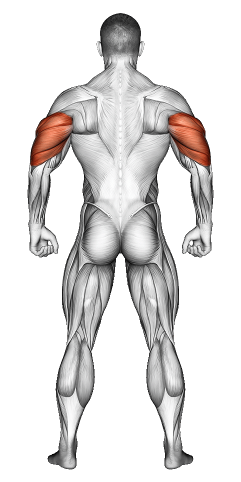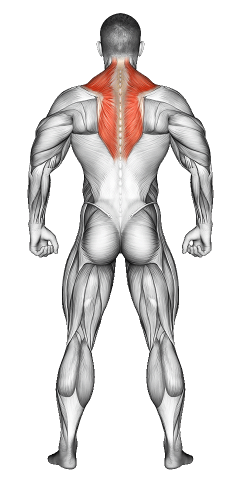Bent Over Dumbbell Tricep Kickback: Video Tutorial & Exercise Guide

Written By: Claude Michael
Updated: Oct 13, 2024
| Workout | Bent Over Dumbbell Tricep Kickback |
| Primary Muscle Group | Triceps |
| Secondary Muscle Group | Shoulders |
| Equipment Required | Dumbbell |
| Force Type | Push |
| Mechanics | Isolation |
| Exercise Type | Strength |
| Difficulty | Intermediate |
Bent Over Dumbbell Tricep Kickback: Video Tutorial & Exercise Guide
- 1.Bent Over Dumbbell Tricep Kickback: Muscle Groups
- -1.1Primary Muscle Group
- -1.2Secondary Muscle Group
- 2.Bent Over Dumbbell Tricep Kickback: Step-by-Step Guide
- 3.Bent Over Dumbbell Tricep Kickback: Overview
- 4.Bent Over Dumbbell Tricep Kickback: Benefits
- 5.Bent Over Dumbbell Tricep Kickback: Pro Tips & Advanced Techniques
- 6.Bent Over Dumbbell Tricep Kickback: Progression Plan
- 7.Bent Over Dumbbell Tricep Kickback: Frequently Asked Questions (FAQs)
Secondary Muscles Group
Bent Over Dumbbell Tricep Kickback: Step-by-Step Guide
- Step 1: Stand with your feet hip-width apart, holding a dumbbell in each hand. Hinge at your hips and bend your knees slightly, keeping your back flat and chest lifted. Your torso should be at a 45-degree angle to the floor.
- Step 2: Keep your elbows close to your body and bend them to form a 90-degree angle. This is the starting position for the kickback.
- Step 3: Engage your triceps and extend your arms fully behind you, straightening your elbows while keeping your upper arms stationary. Squeeze your triceps at the top of the movement.
- Step 4: Slowly bend your elbows to return the dumbbells to the starting position, keeping control of the weights throughout the movement.
- Step 5: Repeat for the desired number of reps, ensuring your upper arms remain stationary and your core stays engaged.
Bent Over Dumbbell Tricep Kickback: Overview
The Bent Over Dumbbell Tricep Kickback is a highly effective exercise that isolates the triceps, helping to build strength and definition in the back of the upper arms. The bent-over position helps engage the core and lower back for stability while allowing you to focus on the tricep contraction.
Suitable for all fitness levels, this exercise can be performed with light or heavy weights, depending on your strength and goals. It is often included in upper body and arm routines to enhance tricep development.
Bent Over Dumbbell Tricep Kickbacks: Benefits
Bent Over Dumbbell Tricep Kickbacks effectively target the triceps, helping to build stronger, more defined arms. This exercise isolates the triceps, minimizing the involvement of other muscles and allowing for focused tricep activation. By maintaining a bent-over position, it also engages the core and lower back for stability, improving your overall body control.
This exercise is particularly beneficial for sculpting the back of the arms, which can enhance the aesthetics of the upper body. It also improves arm strength, making it useful for functional movements that involve pushing and lifting.
Bent Over Dumbbell Tricep Kickback: Pro Tips & Advanced Techniques
Focus on keeping your upper arms stationary throughout the movement to ensure your triceps are doing the work. Avoid swinging the dumbbells or using momentum, and control the movement both when extending and bending your elbows. For added intensity, slow down the eccentric phase (lowering) of the movement to increase time under tension, or pause at the top of the kickback to squeeze your triceps for a second or two.
Bent Over Dumbbell Tricep Kickbacks: Progression Plan
Beginner
Intermediate
Advanced
Bent Over Dumbbell Tricep Kickback: Frequently Asked Questions (FAQs)
What muscles do Bent Over Dumbbell Tricep Kickbacks target?
+Bent Over Dumbbell Tricep Kickbacks primarily target the triceps. They also engage the core and lower back for stability in the bent-over position.
Are Bent Over Dumbbell Tricep Kickbacks suitable for beginners?
+Yes, this exercise is beginner-friendly. Start with light weights to ensure you can perform the movement with proper form before increasing the load.
How often should I include Bent Over Dumbbell Tricep Kickbacks in my routine?
+Include this exercise in your upper body or arm workout routine 1-2 times per week, allowing adequate recovery time for your triceps between sessions.
What common mistakes should I avoid?
+Avoid swinging the dumbbells or using momentum. Keep your upper arms stationary and focus on slow, controlled movements to isolate the triceps effectively.
How can I make Bent Over Dumbbell Tricep Kickbacks more challenging?
+To increase difficulty, you can use heavier dumbbells, slow down the lowering phase, or add a pause at the top of the movement to increase time under tension.
Share
Don’t Wish for It, Work for It – Join the FlexXP Newsletter Today!
Thank you for signing up for the FlexXP Newsletter!
This site is protected and the Google Privacy Policy and Terms of Service apply.

